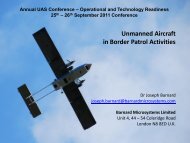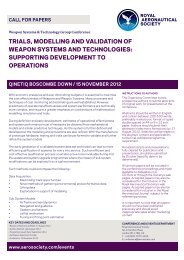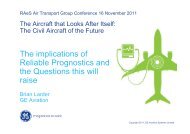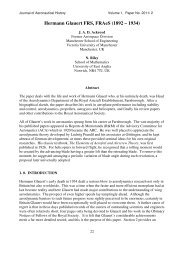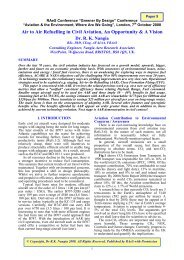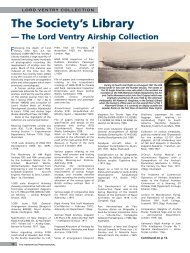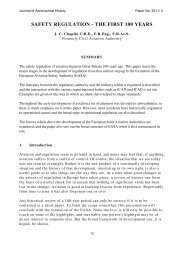one hundred years of gh bryan's stability in aviation - Royal ...
one hundred years of gh bryan's stability in aviation - Royal ...
one hundred years of gh bryan's stability in aviation - Royal ...
Create successful ePaper yourself
Turn your PDF publications into a flip-book with our unique Google optimized e-Paper software.
Journal <strong>of</strong> Aeronautical History Paper No. 2011/ 4<br />
ONE HUNDRED YEARS OF G. H. BRYAN'S STABILITY IN<br />
AVIATION<br />
T. J. M. Boyd<br />
Centre for Physics, University <strong>of</strong> Essex, Wivenhoe Park, Colchester CO7 6AD<br />
SUMMARY<br />
Few books <strong>in</strong> mathematics or the physical sciences pass the endurance test <strong>of</strong> be<strong>in</strong>g remembered<br />
<strong>in</strong> the literature, a <strong>hundred</strong> <strong>years</strong> on. George Hartley Bryan's classic Stability <strong>in</strong> Aviation is <strong>one</strong><br />
<strong>of</strong> these. This paper traces the roots <strong>of</strong> Bryan's early research on <strong>stability</strong> and his <strong>in</strong>terests <strong>in</strong><br />
thermodynamics and statistical physics, which brou<strong>gh</strong>t him <strong>in</strong>to contact and collaboration with<br />
Ludwig Boltzmann. It is argued that Boltzmann's enthusiasm for Otto Lilienthal's experiments<br />
with gliders awakened Bryan's <strong>in</strong>terest <strong>in</strong> fli<strong>gh</strong>t and that it was Lilienthal's fatal accident <strong>in</strong> 1896<br />
that conv<strong>in</strong>ced Bryan that <strong>aviation</strong> would only be feasible once the <strong>stability</strong> <strong>of</strong> aircraft was<br />
understood. Some <strong>of</strong> the events that conspired to delay the publication <strong>of</strong> Stability <strong>in</strong> Aviation<br />
until 1911 are chronicled, along with a redress <strong>of</strong> the largely unremembered contribution to the<br />
book made by Edgar Henry Harper.<br />
1. INTRODUCTION<br />
Stability <strong>in</strong> Aviation [1] written by George Hartley Bryan and published <strong>in</strong> 1911 is <strong>one</strong> <strong>of</strong> that<br />
small category <strong>of</strong> books that cont<strong>in</strong>ue to be widely referenced, if rarely read, a <strong>hundred</strong> <strong>years</strong> on.<br />
Indeed it may never have enjoyed wide readership, with its pages <strong>of</strong> algebra enli<strong>gh</strong>tened only<br />
occasionally by physical <strong>in</strong>si<strong>gh</strong>ts. There was just <strong>one</strong> edition and no translations <strong>in</strong>to other<br />
languages. In contrast, Frederick William Lanchester's two-volume Aerial Fli<strong>gh</strong>t [2], first<br />
published <strong>in</strong> 1907-8, went throu<strong>gh</strong> several editions with the second volume translated <strong>in</strong>to<br />
German and French. The publication <strong>of</strong> Stability <strong>in</strong> Aviation came almost a decade after Bryan's<br />
first foray <strong>in</strong>to the <strong>stability</strong> <strong>of</strong> fli<strong>gh</strong>t <strong>in</strong> a paper written with his student William Ellis Williams<br />
and published [3] co<strong>in</strong>cidentally a few weeks after the Wri<strong>gh</strong>t brothers had flown their Flyer for<br />
the first time near Kitty Hawk, North Carol<strong>in</strong>a on December 17, 1903. Bryan and Williams set<br />
out to show that the longitud<strong>in</strong>al <strong>stability</strong> <strong>of</strong> aeroplane systems can be made the subject <strong>of</strong><br />
mathematical calculation and to draw the attention <strong>of</strong> those <strong>in</strong>terested <strong>in</strong> the problem <strong>of</strong> artificial<br />
fli<strong>gh</strong>t to the necessity <strong>of</strong> acquir<strong>in</strong>g further experimental knowledge concern<strong>in</strong>g the quantities on<br />
which this <strong>stability</strong> is shown to depend. Seem<strong>in</strong>gly, few were <strong>in</strong>terested. In the words <strong>of</strong> his<br />
obituarist, Selig Brodetsky: This mathematical theory ga<strong>in</strong>ed the approval neither <strong>of</strong><br />
mathematicians nor <strong>of</strong> those brave pi<strong>one</strong>ers, who demonstrated the practicability <strong>of</strong> aeroplane<br />
fli<strong>gh</strong>t…..But Bryan persevered <strong>in</strong> his somewhat l<strong>one</strong>ly work and seven <strong>years</strong> later he published<br />
his Stability <strong>in</strong> Aviation, a book that may now be reck<strong>one</strong>d as a classic <strong>in</strong> aeroplane theory, [4].<br />
Brodetsky's verdict has echoed down the <strong>years</strong>, the book praised <strong>in</strong> turn as epochal, [5], <strong>one</strong> that<br />
completely changed the theoretical outlook, [6] and astonish<strong>in</strong>gly modern, [7]. Cont<strong>in</strong>u<strong>in</strong>g<br />
references to Stability <strong>in</strong> Aviation stand testament to Bryan's niche <strong>in</strong> the pantheon <strong>of</strong> pi<strong>one</strong>ers <strong>of</strong><br />
fli<strong>gh</strong>t.<br />
97
Journal <strong>of</strong> Aeronautical History Paper No. 2011/ 4<br />
Less well known is Bryan's world stand<strong>in</strong>g <strong>in</strong> thermodynamics and statistical mechanics <strong>in</strong> the<br />
<strong>years</strong> lead<strong>in</strong>g up to the publication <strong>of</strong> Stability <strong>in</strong> Aviation and the contrast<strong>in</strong>g low esteem <strong>in</strong><br />
which he was held at Bangor, where he served for thirty <strong>years</strong> as Pr<strong>of</strong>essor <strong>of</strong> Mathematics <strong>in</strong> the<br />
University College <strong>of</strong> North Wales. When he retired <strong>in</strong> 1926 to Bordi<strong>gh</strong>era <strong>in</strong> Italy, no formal<br />
tributes were paid and shortly after his death all the Pr<strong>in</strong>cipal, Sir Harry Reichel, could manage<br />
was a graceless aside, "Yes, we made a mistake there!" Sixty <strong>years</strong> on, he was chronicled as<br />
hav<strong>in</strong>g been largely remembered because <strong>of</strong> a multitude <strong>of</strong> absurd episodes….if he sometimes<br />
seemed a colossal buffoon, he himself did not help matters by proclaim<strong>in</strong>g that he did his best<br />
work under the <strong>in</strong>fluence <strong>of</strong> alcohol, [8].<br />
This outl<strong>in</strong>e <strong>of</strong> the vicissitudes <strong>of</strong> Bryan's career, up to the publication <strong>of</strong> Stability <strong>in</strong> Aviation <strong>in</strong><br />
1911, <strong>of</strong>fers fresh <strong>in</strong>si<strong>gh</strong>ts on the man and those who <strong>in</strong>fluenced him, n<strong>one</strong> more than Ludwig<br />
Boltzmann, heir to Maxwell and doyen <strong>of</strong> European theoretical physics at the end <strong>of</strong> the<br />
n<strong>in</strong>eteenth century. The friendship that began at their first meet<strong>in</strong>g <strong>in</strong> 1894 lasted until<br />
Boltzmann's tragic suicide <strong>in</strong> 1906. Not only did Boltzmann's <strong>in</strong>fluence promote Bryan's surge to<br />
the forefront <strong>of</strong> thermodynamics and statistical physics, his enthusiasm for Lilienthal's<br />
experiments with gliders made a last<strong>in</strong>g impression on Bryan. It was the <strong>in</strong>sistent tug <strong>of</strong><br />
thermodynamics and the stress <strong>of</strong> his early <strong>years</strong> at Bangor that comb<strong>in</strong>ed to thwart Bryan's first<br />
campaign on the new science <strong>of</strong> fli<strong>gh</strong>t. Even after the publication <strong>of</strong> his work on longitud<strong>in</strong>al<br />
<strong>stability</strong> with Williams, another five <strong>years</strong> went by before he returned to the subject. It took the<br />
publication <strong>of</strong> his rival Lanchester's results on <strong>stability</strong> to galvanise him <strong>in</strong>to action. After the<br />
publication <strong>of</strong> Stability <strong>in</strong> Aviation, others, notably Leonard Bairstow, would play a pivotal role<br />
<strong>in</strong> mak<strong>in</strong>g Bryan's results accessible to aeroplane design eng<strong>in</strong>eers, but as for Stability <strong>in</strong> Aviation<br />
itself, it was n<strong>one</strong> <strong>of</strong> these but a name now unremembered, Edgar Harper, who contributed most.<br />
A <strong>hundred</strong> <strong>years</strong> on, it is more than time to redress the oversi<strong>gh</strong>t <strong>of</strong> Harper's contributions to<br />
Stability <strong>in</strong> Aviation.<br />
2. BEGINNINGS AND FIRST STEPS IN STABILITY<br />
Bryan's obituarists and biographers alike agree on the uniqueness and durability <strong>of</strong> his<br />
contributions to aeroplane <strong>stability</strong> and the eccentricity that marked him as a man. It was a trait<br />
that owed a good deal to his early life. George Hartley Bryan was born at Cambridge on March<br />
1, 1864. His father died young and Bryan, an only child, was brou<strong>gh</strong>t up by his mother and<br />
grandmother. Much <strong>of</strong> his childhood was spent abroad, for the most part <strong>in</strong> Italy, with the result<br />
that he grew up fluent <strong>in</strong> Italian and pr<strong>of</strong>icient <strong>in</strong> both German and French. Supposedly delicate<br />
he did not attend school, a drawback that may have contributed to his at times awkward relations<br />
with colleagues <strong>in</strong> later life. Even when admitted to Cambridge <strong>in</strong> 1883 as a Scholar <strong>of</strong><br />
Peterhouse, he cont<strong>in</strong>ued to live at home. Indulged by his mother and grandmother alike, it is<br />
small wonder Bryan grew up expect<strong>in</strong>g to have his own way. He graduated <strong>in</strong> 1886, fifth <strong>in</strong> the<br />
list <strong>of</strong> Wranglers and was subsequently named as Smith's Prizeman for a dissertation on the<br />
<strong>stability</strong> <strong>of</strong> a rotat<strong>in</strong>g mass <strong>of</strong> fluid. It was a topic proposed by G.H. Darw<strong>in</strong>, Bryan's early mentor<br />
and Darw<strong>in</strong>'s second son, <strong>one</strong> that had engaged no less than Po<strong>in</strong>caré and Riemann, as good<br />
company as <strong>one</strong> could keep <strong>in</strong> late n<strong>in</strong>eteenth-century mathematics. The seeds <strong>of</strong> his <strong>in</strong>terest <strong>in</strong><br />
98
Journal <strong>of</strong> Aeronautical History Paper No. 2011/ 4<br />
<strong>stability</strong>, sown by Darw<strong>in</strong>, would flower from time to time, not <strong>in</strong>frequently with some practical<br />
application <strong>in</strong> m<strong>in</strong>d, and were to come to fruition <strong>in</strong> the work with which his name is ever<br />
associated, the <strong>stability</strong> <strong>of</strong> fli<strong>gh</strong>t.<br />
Elected to a fellowship at Peterhouse <strong>in</strong> 1889, it soon became clear that Bryan had <strong>in</strong>terests<br />
beyond <strong>stability</strong>. We may never be sure what, or who, triggered Bryan's <strong>in</strong>terest <strong>in</strong><br />
thermodynamics and statistical mechanics, but Joseph Larmor seems as likely as any. Larmor<br />
was prom<strong>in</strong>ent <strong>in</strong> the Maxwellians, a group dedicated to advanc<strong>in</strong>g the brilliant <strong>in</strong>si<strong>gh</strong>ts <strong>in</strong> James<br />
Clerk Maxwell's books, Theory <strong>of</strong> Heat and Electricity and Magnetism. It appears that Bryan had<br />
the idea <strong>of</strong> review<strong>in</strong>g thermodynamics <strong>in</strong> a report to the British Association, [9]. It would have<br />
been tempt<strong>in</strong>g fate for a mathematician <strong>in</strong> his mid-twenties to review a subject to which he<br />
himself had made no contribution, before an audience with Kelv<strong>in</strong>, its very godfather, present<br />
along with George Francis Fitzgerald, Pr<strong>of</strong>essor <strong>of</strong> Natural Philosophy at Tr<strong>in</strong>ity College Dubl<strong>in</strong>,<br />
two <strong>of</strong> the most formidable protagonists <strong>in</strong> the Association's Section A. On top <strong>of</strong> his<br />
eccentricity, Bryan already had someth<strong>in</strong>g <strong>of</strong> a reputation as a loose cannon, his papers<br />
punctuated with critical comment not calculated to endear him to its targets. It may be that the<br />
British Association saw fit to temper any excesses by add<strong>in</strong>g Larmor as co-author. Their report,<br />
On the present State <strong>of</strong> our Knowledge <strong>of</strong> Thermodynamics [10], presented at Cardiff <strong>in</strong> 1891 was<br />
well received and it was resolved that the work be cont<strong>in</strong>ued. So without hav<strong>in</strong>g contributed<br />
anyth<strong>in</strong>g orig<strong>in</strong>al <strong>in</strong> thermodynamics, Bryan's name had wider currency abroad.<br />
3. BRYAN AND BOLTZMANN: FROM THERMODYNAMICS TO<br />
AERODYNAMICS<br />
Part II did not appear for another three <strong>years</strong> and was presented to the British Association<br />
Meet<strong>in</strong>g at Oxford <strong>in</strong> 1894, with Bryan as sole author. This report, On the Laws <strong>of</strong> Distribution <strong>of</strong><br />
Energy and their Limitations, [11], was sharply focused <strong>in</strong> that he set out to address the question:<br />
What precisely is Maxwell's law <strong>of</strong> equipartition and under what conditions is it true? It was<br />
Bryan's good fortune that the guest <strong>of</strong> honour that year was n<strong>one</strong> other than Ludwig Boltzmann,<br />
co-founder with Maxwell <strong>of</strong> the k<strong>in</strong>etic theory <strong>of</strong> gases. Boltzmann is recorded as hav<strong>in</strong>g eagerly<br />
taken part <strong>in</strong> the discussion <strong>of</strong> Bryan's report, a discussion that was to be susta<strong>in</strong>ed over several<br />
months <strong>in</strong> letters to Nature. At the meet<strong>in</strong>g, the debate, led by the arch-disputant Fitzgerald,<br />
rather discomfited Boltzmann. Now remembered for the boldness <strong>of</strong> his famous contraction, it is<br />
hard today to credit the <strong>in</strong>fluence Fitzgerald exercised over his contemporaries. With an impos<strong>in</strong>g<br />
presence and the ready tongue <strong>of</strong> a Dubl<strong>in</strong>er, he had few equals <strong>in</strong> debate. Bryan recalled with<br />
relish the memorable field day on k<strong>in</strong>etic theory at Oxford, s<strong>in</strong>gl<strong>in</strong>g out the onslau<strong>gh</strong>t by<br />
Fitzgerald…. Pr<strong>of</strong>. Boltzmann made no attempt to answer…..he several times menti<strong>one</strong>d the<br />
question to me after the debate as <strong>one</strong> that had not been satisfactorily cleared up. By no means<br />
fluent <strong>in</strong> English, it is small wonder Boltzmann was left speechless by the onslau<strong>gh</strong>t <strong>in</strong><br />
Fitzgerald's Dubl<strong>in</strong>speak. He would have been glad <strong>of</strong> the opportunity to mull th<strong>in</strong>gs over with<br />
Bryan <strong>in</strong> German. Despite the twenty year gap <strong>in</strong> age and the even wider chasm between a man at<br />
the p<strong>in</strong>nacle <strong>of</strong> theoretical physics and a young mathematician mak<strong>in</strong>g his reputation, it seems<br />
Boltzmann and Bryan took to <strong>one</strong> another. Their discussions at Oxford led to the publication <strong>of</strong> a<br />
jo<strong>in</strong>t paper, [12].<br />
99
Journal <strong>of</strong> Aeronautical History Paper No. 2011/ 4<br />
While k<strong>in</strong>etic theory was the focus <strong>in</strong> Section A at Oxford, Bryan doubtless heard from<br />
Boltzmann about the lecture, On Aviation, he was due to deliver on his return to Vienna, [13].<br />
Boltzmann had not only read Otto Lilienthal's book on the fli<strong>gh</strong>t <strong>of</strong> birds, [14], but took great<br />
<strong>in</strong>terest <strong>in</strong> his experiments on gliders. Fly<strong>in</strong>g was on Boltzmann's m<strong>in</strong>d that summer. He had<br />
written to Lilienthal before travell<strong>in</strong>g to Oxford and some weeks after his return, wrote aga<strong>in</strong>, this<br />
time ask<strong>in</strong>g for a quote for a glider powered with a rotat<strong>in</strong>g eng<strong>in</strong>e. Another guest at Oxford was<br />
Samuel Pierpont Langley, the American astrophysicist turned aerodynamics pi<strong>one</strong>er. A few <strong>years</strong><br />
earlier, Langley had published his Experiments <strong>in</strong> Aerodynamics [15]. Report<strong>in</strong>g his latest<br />
f<strong>in</strong>d<strong>in</strong>gs, he had an even rou<strong>gh</strong>er ride than Boltzmann, attacked by both Raylei<strong>gh</strong> and Kelv<strong>in</strong>.<br />
Kelv<strong>in</strong> was reactionary as far as fly<strong>in</strong>g was concerned; <strong>in</strong>vited to become a member <strong>of</strong> the<br />
Aeronautical Society, he replied say<strong>in</strong>g that I have not the sli<strong>gh</strong>test molecule <strong>of</strong> faith <strong>in</strong> aerial<br />
navigation….So you will understand that I would not care to be a member, [16]. Raylei<strong>gh</strong>, on the<br />
other hand, was <strong>in</strong>terested <strong>in</strong> manned fli<strong>gh</strong>t and brou<strong>gh</strong>t news <strong>of</strong> Maxim's recent experiments to<br />
Boltzmann's notice, [17]. Fitzgerald too cau<strong>gh</strong>t Boltzmann's <strong>in</strong>fectious enthusiasm for Lilienthal's<br />
experiments. True to form, he lost no time <strong>in</strong> gett<strong>in</strong>g <strong>in</strong> on the act, order<strong>in</strong>g a glider early <strong>in</strong> 1895,<br />
the first <strong>in</strong> Brita<strong>in</strong> and Ireland, for which he paid Lilienthal £25 (500Marks). The delivery that<br />
summer was billed as a Normal Segelapparat ; its purpose described as Erprobung als Drachen;<br />
Versuche durch Studenten (test<strong>in</strong>g as a kite; experiments by students), [18]. Boltzmann<br />
seem<strong>in</strong>gly decided not to go ahead with his purchase. It was little wonder that Bryan, listen<strong>in</strong>g to<br />
Langley and talk<strong>in</strong>g with Boltzmann and Fitzgerald, was fired by their enthusiasm for fli<strong>gh</strong>t. But<br />
age, if noth<strong>in</strong>g else, set Bryan apart. At 30, <strong>of</strong> a new generation, his reputation had yet to be<br />
cemented; hav<strong>in</strong>g made his mark at Oxford, a switch <strong>of</strong> <strong>in</strong>terests from thermodynamics to<br />
aerodynamics could have been seen as ill-advised, with his fellowship com<strong>in</strong>g to an end. Joseph<br />
Larmor would surely have cauti<strong>one</strong>d aga<strong>in</strong>st <strong>in</strong>volvement <strong>in</strong> this new <strong>in</strong>terest; <strong>one</strong> <strong>of</strong> nature's<br />
conservatives, Larmor had misgiv<strong>in</strong>gs about motor cars, let al<strong>one</strong> aeroplanes.<br />
Fly<strong>in</strong>g was <strong>in</strong> the air <strong>in</strong> 1894, not only at the British Association. That summer, a 26-year old<br />
eng<strong>in</strong>eer, Frederick William Lanchester, read a paper to the Birm<strong>in</strong><strong>gh</strong>am Natural History and<br />
Philosophical Society on The Soar<strong>in</strong>g <strong>of</strong> Birds and the Possibilities <strong>of</strong> Mechanical Fli<strong>gh</strong>t.<br />
Lanchester, a designer for the Forward Gas Eng<strong>in</strong>e Company, experimented with gliders <strong>in</strong> his<br />
spare time. In later life he recalled that he had been warned that his pr<strong>of</strong>ession as an eng<strong>in</strong>eer<br />
would suffer if he dabbled <strong>in</strong> a subject that was merely a dream <strong>of</strong> madmen. Fortunately he had<br />
the means to pay for his hobby out <strong>of</strong> his own pocket and could <strong>in</strong>dulge his dream regardless.<br />
4. BRYAN AT BANGOR: BEGINNINGS<br />
Back at Cambridge, Bryan had the satisfaction <strong>of</strong> see<strong>in</strong>g the debate his Report had sparked at the<br />
British Association re-ignited <strong>in</strong> the columns <strong>of</strong> Nature, exchanges that ran to twenty five letters<br />
<strong>in</strong>to 1895, no fewer than six from Bryan himself. Bryan's stand<strong>in</strong>g as <strong>one</strong> <strong>of</strong> the leaders <strong>in</strong> k<strong>in</strong>etic<br />
theory was assured and that year saw his election to the <strong>Royal</strong> Society. It also marked the end <strong>of</strong><br />
his fellowship at Peterhouse. He stayed at Cambridge until the summer <strong>of</strong> 1896 when he was<br />
appo<strong>in</strong>ted Temporary Lecturer <strong>in</strong> Mathematics at the University College <strong>of</strong> North Wales. How<br />
and why Bryan came to be appo<strong>in</strong>ted to a temporary lectureship at Bangor is a mystery. Was it<br />
100
Journal <strong>of</strong> Aeronautical History Paper No. 2011/ 4<br />
thou<strong>gh</strong>t advisable that the College should take a good look at Bryan before mak<strong>in</strong>g an election to<br />
the Chair vacated that summer by George Ballard Matthews, who had retreated back to<br />
Cambridge, disillusi<strong>one</strong>d after twelve <strong>years</strong> at Bangor? Whatever the reason, the Registrar at<br />
Bangor wrote <strong>in</strong> late September advis<strong>in</strong>g Bryan: ….The permanent appo<strong>in</strong>tment, to which the<br />
temporary gives no claim, will ….be made <strong>in</strong> December. Read<strong>in</strong>g between the l<strong>in</strong>es, it seems not<br />
unlikely that Bryan had been given a nod and a w<strong>in</strong>k that he had every chance <strong>of</strong> success. So it<br />
happened that the College Council appo<strong>in</strong>ted Bryan to the Chair <strong>of</strong> Mathematics at their meet<strong>in</strong>g<br />
on December 14, 1896. He was to stay at Bangor until his retirement thirty <strong>years</strong> later.<br />
Bryan got news <strong>of</strong> his temporary appo<strong>in</strong>tment at Liverpool, venue for that year's British<br />
Association. The seeds sown by Boltzmann two <strong>years</strong> before had germ<strong>in</strong>ated, but where<br />
Fitzgerald ordered a glider, Bryan had settled for a copy <strong>of</strong> Lilienthal's book on bird fli<strong>gh</strong>t and<br />
read a paper On the Sail<strong>in</strong>g Fli<strong>gh</strong>t <strong>of</strong> Birds. At Liverpool, the talk was <strong>of</strong> Lilienthal's fatal<br />
accident just weeks before, when his glider had been struck by a sudden gust. Alas, poor<br />
Lilienthal, Oliver Lodge had scribbled <strong>in</strong> a note to Fitzgerald just before the meet<strong>in</strong>g. The news<br />
would have sobered Fitzgerald who had been attempt<strong>in</strong>g to fly his glider, bou<strong>gh</strong>t the year before.<br />
Hauled by stalwarts from the TCD rugby and hurl<strong>in</strong>g clubs, it seems the best they could manage<br />
was to get the pr<strong>of</strong>essor a few feet <strong>of</strong>f the ground. It is doubtful if he took to the air aga<strong>in</strong>.<br />
Arrived at Bangor, Bryan's immediate concerns would have been to get mathematics classes<br />
organised for the term about to start. Look<strong>in</strong>g from his college w<strong>in</strong>dow at the seagulls sail<strong>in</strong>g<br />
over Port Penrhyn, he would have seen "Nature's aeroplanes" at first hand, masters <strong>of</strong> control,<br />
impervious to the gusts that had proved fatal to Lilienthal. More than anyth<strong>in</strong>g, Lilienthal's<br />
accident had conv<strong>in</strong>ced Bryan that <strong>stability</strong> was key to success <strong>in</strong> fly<strong>in</strong>g and that an<br />
understand<strong>in</strong>g <strong>of</strong> it would save lives. Intent on turn<strong>in</strong>g his attention from the subtleties <strong>of</strong> the Htheorem<br />
to the <strong>in</strong>tricacies <strong>of</strong> <strong>stability</strong>, he lectured on Progress <strong>in</strong> Manned Fli<strong>gh</strong>t at the <strong>Royal</strong><br />
Armoury, Woolwich <strong>in</strong> 1896 and early <strong>in</strong> 1897 spoke to the College Scientific Society on fly<strong>in</strong>g,<br />
enterta<strong>in</strong><strong>in</strong>g his audience by launch<strong>in</strong>g model gliders <strong>in</strong> the lecture theatre. Later that year he<br />
contributed a Review <strong>of</strong> Artificial Fli<strong>gh</strong>t, [19], <strong>in</strong> which he drew attention to the crucial role <strong>of</strong><br />
<strong>stability</strong>. As it happened, he was not al<strong>one</strong> <strong>in</strong> identify<strong>in</strong>g the significance <strong>of</strong> aeroplane <strong>stability</strong>.<br />
That same year Lanchester submitted a paper develop<strong>in</strong>g his 1894 lecture, first to the <strong>Royal</strong><br />
Society and then to the Physical Society <strong>of</strong> London, where it was rejected. It was a setback that<br />
rankled with its combative author <strong>years</strong> later. All Lanchester could salvage from his efforts <strong>in</strong><br />
1897 was a patent on the theory <strong>of</strong> <strong>stability</strong>. Bryan's own campaign on the <strong>stability</strong> <strong>of</strong> fli<strong>gh</strong>t was<br />
about to suffer a setback, <strong>one</strong> that would threaten the <strong>stability</strong> <strong>of</strong> his department.<br />
4.1 In<strong>stability</strong> at Bangor: the "Bryan affair"<br />
The first <strong>of</strong> the happen<strong>in</strong>gs that blew Bryan's campaign <strong>of</strong>f course stemmed from the very nature<br />
<strong>of</strong> his appo<strong>in</strong>tment. As Pr<strong>of</strong>essor <strong>of</strong> Pure and Applied Mathematics he was charged with teach<strong>in</strong>g<br />
and exam<strong>in</strong><strong>in</strong>g <strong>in</strong> mathematics, with the help <strong>of</strong> an assistant, David Edwardes, a graduate <strong>in</strong><br />
mathematics from Tr<strong>in</strong>ity College Dubl<strong>in</strong>, appo<strong>in</strong>ted under Bryan's predecessor. Ballard<br />
Matthews was so exquisitely sensitive that it would never have occurred to him to assign duties<br />
to his assistant, with the result that Edwardes pretty much suited himself. Bryan, on the other<br />
hand, to whom gett<strong>in</strong>g his own way was virtually impr<strong>in</strong>ted on his DNA, wanted all the<br />
101
Journal <strong>of</strong> Aeronautical History Paper No. 2011/ 4<br />
assistance he could get, to allow time for research. In all likelihood he had precious little <strong>in</strong>kl<strong>in</strong>g<br />
<strong>of</strong> what was <strong>in</strong> store for him at Bangor, with twelve or more lectures to deliver each week. An<br />
early annual report to the College Council compla<strong>in</strong>s that …Sett<strong>in</strong>g and look<strong>in</strong>g over exercises<br />
occupies more hours every week than the lectures themselves. On top <strong>of</strong> that, coco<strong>one</strong>d at<br />
Cambridge for so long, he had little notion <strong>of</strong> how to go about organis<strong>in</strong>g work <strong>in</strong> a small—very<br />
small—department. So with the assistant unwill<strong>in</strong>g and the pr<strong>of</strong>essor unwitt<strong>in</strong>g and at times<br />
unwell dur<strong>in</strong>g the session 1897/8, it was small wonder that mathematics at Bangor was headed<br />
for the rocks.<br />
On top <strong>of</strong> his fractious relations with Edwardes, Bryan faced problems <strong>of</strong> his own. The class with<br />
by far the biggest enrolment, the Matriculation Class, was traditionally the preserve <strong>of</strong> the<br />
pr<strong>of</strong>essor. A wonderfully graphic account <strong>of</strong> the go<strong>in</strong>gs-on was broadcast <strong>years</strong> later by a<br />
member <strong>of</strong> the class <strong>of</strong> 1899, Thomas Richards [20]:<br />
There is not such a class <strong>in</strong> the Colleges <strong>of</strong> the University for <strong>years</strong> now, and a good job too! A<br />
fair <strong>hundred</strong> <strong>in</strong> number…<strong>in</strong> the front rows a number <strong>of</strong> red-cheeked lads from Anglesey and<br />
Arfon, shy to beg<strong>in</strong> with, sons <strong>of</strong> farmers, who had been advised by the Pr<strong>of</strong>essor <strong>of</strong> Agriculture<br />
to get acqua<strong>in</strong>ted a little with the world <strong>of</strong> sums. Beh<strong>in</strong>d them, preachers from different<br />
denom<strong>in</strong>ations, considered weak <strong>in</strong> number and measure. Then, <strong>in</strong> the middle, benches <strong>of</strong> women,<br />
liable to lau<strong>gh</strong> irrationally at the strange happen<strong>in</strong>gs <strong>of</strong> the world about them. At the back, the<br />
two-year Normals….full <strong>of</strong> mischief. From their number came the happen<strong>in</strong>gs. As sure as<br />
anyth<strong>in</strong>g, sometime <strong>in</strong> the Autumn term <strong>one</strong> <strong>of</strong> them would suddenly fall unconscious to the<br />
ground,….a group <strong>of</strong> his fellow-travellers rush<strong>in</strong>g to carry him with the pr<strong>of</strong>essor <strong>in</strong> front to a<br />
private room, Bryan reach<strong>in</strong>g from the cupboard a vessel <strong>of</strong> strong dr<strong>in</strong>k and pour<strong>in</strong>g a<br />
substantial ration <strong>of</strong> it down the throat <strong>of</strong> the unfortunate. Then the gradual—very gradual—<br />
com<strong>in</strong>g-to and <strong>one</strong> <strong>of</strong> his fellows help<strong>in</strong>g him back to his place. What hope for number and<br />
measure for the rest <strong>of</strong> that hour?<br />
What hope for <strong>stability</strong> and control, at times restored only by the <strong>in</strong>tervention <strong>of</strong> the Pr<strong>in</strong>cipal?<br />
Reichel mi<strong>gh</strong>t have been forgiven for harbour<strong>in</strong>g doubts about Bryan. Strai<strong>gh</strong>t-laced scion <strong>of</strong> the<br />
Bishop <strong>of</strong> Meath, remote <strong>in</strong> his deal<strong>in</strong>gs with staff and students alike, the Pr<strong>in</strong>cipal would have<br />
wanted no truck with a colleague who kept whiskey <strong>in</strong> his cupboard, whether as restorative for<br />
stricken matriculants or stimulant to his own research. Go<strong>in</strong>g <strong>in</strong>to 1899, the very <strong>stability</strong> <strong>of</strong> the<br />
Mathematics Department was threatened by the near total breakdown <strong>in</strong> communication between<br />
pr<strong>of</strong>essor and assistant. The College Council set up a Committee <strong>of</strong> Inquiry. W<strong>in</strong>d <strong>of</strong> the rumpus<br />
spread outside Bangor, mathematicians writ<strong>in</strong>g to <strong>one</strong> another with news <strong>of</strong> the "Bryan affair".<br />
Bryan suffered a nervous breakdown, retir<strong>in</strong>g hurt to Cambridge. The <strong>in</strong>quiry <strong>in</strong> the end <strong>of</strong>fered<br />
no resolution beyond undertak<strong>in</strong>gs <strong>of</strong> cooperation from both parties for the benefit <strong>of</strong> their<br />
students. The truce lasted throu<strong>gh</strong> the next session before trouble brewed aga<strong>in</strong>. The breach <strong>in</strong><br />
relations between Bryan and Reichel never mended. Bryan felt betrayed by the Pr<strong>in</strong>cipal's lack <strong>of</strong><br />
support, while Reichel had come to rue the appo<strong>in</strong>tment <strong>of</strong> a hi<strong>gh</strong>ly eccentric and questionably<br />
competent Pr<strong>of</strong>essor <strong>of</strong> Mathematics.<br />
4.2 Equilibrium restored<br />
Freed for the time be<strong>in</strong>g from the yoke <strong>of</strong> Bangor, Bryan had all the hours he needed for research<br />
102
Journal <strong>of</strong> Aeronautical History Paper No. 2011/ 4<br />
and turned, not to the <strong>stability</strong> <strong>of</strong> fli<strong>gh</strong>t, but to the <strong>stability</strong> <strong>of</strong> ships. Of all the motions a ship is<br />
subject to, the need to reduce roll is paramount as this affects seaworth<strong>in</strong>ess. Naval architects<br />
down the <strong>years</strong> had aimed for a design with marg<strong>in</strong> enou<strong>gh</strong> to ensure <strong>stability</strong>, along with bilge<br />
keels, long f<strong>in</strong>s welded <strong>in</strong> pairs along the hull to damp the roll. At the same time they were<br />
puzzled why bilge keels proved more effective aga<strong>in</strong>st roll than conventional theory allowed.<br />
Bryan was able to show that a roll<strong>in</strong>g ship <strong>in</strong>duces an oppos<strong>in</strong>g counter-current which<br />
significantly <strong>in</strong>creases the pressure on the bilge keel, [21]. Work<strong>in</strong>g on ship <strong>stability</strong> Bryan may<br />
well have pondered the full 3D problem <strong>of</strong> aeroplane <strong>stability</strong>. If so, he was aga<strong>in</strong> blown <strong>of</strong>f<br />
course as soon as he got back to Bangor at the end <strong>of</strong> the summer.<br />
In September 1899, Pr<strong>of</strong>essor Arnold Sommerfeld, lately appo<strong>in</strong>ted editor <strong>of</strong> Volume 5 <strong>of</strong> the<br />
Enzyklopädie für Mathematische Wissenschaften, visited him. This monumental work spanned<br />
the known world <strong>of</strong> pure and applied mathematics. Volume 4 on applied mathematics even<br />
stretched to articles on sports science, on the <strong>stability</strong> <strong>of</strong> boomerangs and bicycles; Volume 5 was<br />
to cover physics <strong>in</strong> its early twentieth century entirety. The contributors to a man were drawn<br />
from German mathematics and physics but Sommerfeld wanted to broaden both its base and its<br />
appeal. More than likely his visit to Bangor was at Boltzmann's prompt<strong>in</strong>g. At any rate,<br />
Sommerfeld duly wrote <strong>in</strong>vit<strong>in</strong>g Bryan to contribute the article on thermodynamics, [22]. It was a<br />
signal honour for some<strong>one</strong> outside the orbit <strong>of</strong> German science, not least <strong>in</strong> a subject where there<br />
was no shortage <strong>of</strong> German contenders <strong>of</strong> dist<strong>in</strong>ction, Boltzmann himself or Planck, to name but<br />
two. Bryan took his time to reply, plead<strong>in</strong>g that his time had been very full. What little time he<br />
had beyond his teach<strong>in</strong>g duties had been given to a contribution to a volume celebrat<strong>in</strong>g the<br />
Jubilee <strong>of</strong> Pr<strong>of</strong>essor H.A. Lorentz <strong>of</strong> Leiden, co-doyen with Boltzmann <strong>of</strong> the world <strong>of</strong> theoretical<br />
physics. In late November he wrote thank<strong>in</strong>g Sommerfeld for his <strong>in</strong>vitation, expla<strong>in</strong><strong>in</strong>g that there<br />
would be some delay before he could make a start : S<strong>in</strong>ce you were here I have an <strong>in</strong>vitation to<br />
give a lecture at our <strong>Royal</strong> Institution on Artificial Fli<strong>gh</strong>t next February and this makes me more<br />
busy than ever, [23].<br />
In the end thermodynamics took precedence, for Bryan's discourse on The History and Progress<br />
<strong>of</strong> Aerial Locomotion, [24] was delivered, not <strong>in</strong> February 1900 as <strong>in</strong>tended, but a whole year<br />
later. His approach was broad-brush, thou<strong>gh</strong> presciently Bryan drew attention to the fact that<br />
…<strong>stability</strong>….. should not be <strong>in</strong>vestigated on gravity-propelled mach<strong>in</strong>es al<strong>one</strong>, but that the effects<br />
<strong>of</strong> a motor should be experimentally determ<strong>in</strong>ed. Curiously, with a title referr<strong>in</strong>g to the history <strong>of</strong><br />
fli<strong>gh</strong>t and with his own grasp <strong>of</strong> the importance <strong>of</strong> <strong>stability</strong>, Bryan made no mention <strong>of</strong> the man<br />
acclaimed as the father <strong>of</strong> aeronautics, Sir George Cayley, who had written about the problem <strong>of</strong><br />
longitud<strong>in</strong>al <strong>stability</strong> and control <strong>in</strong> pi<strong>one</strong>er<strong>in</strong>g work almost a century before, [25]. The<br />
postp<strong>one</strong>ment <strong>of</strong> Bryan's discourse on aerial locomotion to 1901 had an <strong>in</strong>trigu<strong>in</strong>g knock-on<br />
effect. It appears that n<strong>one</strong> other than Alexander Graham Bell, who had been experiment<strong>in</strong>g with<br />
gliders at Cape Breton, had been <strong>in</strong>vited to deliver a lecture on the same subject <strong>in</strong> 1901. He must<br />
have been put out on be<strong>in</strong>g sent a pro<strong>of</strong> <strong>of</strong> Bryan's discourse <strong>in</strong> March 1901 and cabled to say<br />
that he <strong>in</strong> turn would postp<strong>one</strong> his lecture. Bell wrote to his wife [26]: So this lecture is <strong>of</strong>f for<br />
the present and I am glad <strong>of</strong> it, for… by giv<strong>in</strong>g such a lecture at the present time I would run a<br />
great chance <strong>of</strong> mak<strong>in</strong>g a fool <strong>of</strong> myself ….. Just fancy my position—with the reputation the<br />
teleph<strong>one</strong> has given me I would appear before the <strong>Royal</strong> Institution as <strong>one</strong> believed to be an<br />
authority upon the subject – for why otherwise should I be <strong>in</strong>vited?.... and then f<strong>in</strong>d that all had<br />
103
Journal <strong>of</strong> Aeronautical History Paper No. 2011/ 4<br />
been previously discovered and published by others…Now I breathe freely and can go to work <strong>in</strong><br />
what seems to me the proper way.<br />
More may have been said on the even<strong>in</strong>g <strong>of</strong> Bryan's discourse than appears <strong>in</strong> the record [24].<br />
One <strong>of</strong> those present, E. S. Bruce, was to recall later [27]: In the course <strong>of</strong> a few remarks on<br />
glid<strong>in</strong>g fli<strong>gh</strong>t made <strong>in</strong> the course <strong>of</strong> his Friday even<strong>in</strong>g discourse, it seemed to me evident that he<br />
had a greater grasp <strong>of</strong> the mathematical side <strong>of</strong> the problem <strong>of</strong> aerial navigation than had been<br />
previously ev<strong>in</strong>ced and at my request, he wrote the remarkable mathematical discourse on the<br />
subject which was read before the Aeronautical Society (on December 3, 1903). That suggests<br />
that Bryan had already made a start on an analysis <strong>of</strong> the longitud<strong>in</strong>al <strong>stability</strong> <strong>of</strong> gliders by early<br />
1901. He was not al<strong>one</strong> <strong>in</strong> his concern. In September 1901, <strong>in</strong> a lecture on Some Aeronautical<br />
Experiments, a bicycle manufacturer from Ohio, Wilbur Wri<strong>gh</strong>t, lifted the curta<strong>in</strong> on glider trials<br />
conducted with his brother, voic<strong>in</strong>g concern over the difficulties they had experienced that<br />
summer controll<strong>in</strong>g longitud<strong>in</strong>al <strong>in</strong><strong>stability</strong>.<br />
As the session wore on, skirmishes with Edwardes flared up aga<strong>in</strong>. Bryan had had enou<strong>gh</strong>. In<br />
early May he wrote to Sommerfeld to ask if he would be will<strong>in</strong>g to write a testimonial <strong>in</strong> support<br />
<strong>of</strong> his application for the Chair <strong>of</strong> Natural Philosophy at Ed<strong>in</strong>bur<strong>gh</strong>. At Bangor, the College<br />
Council set up yet another <strong>in</strong>quiry that this time ruled that the fault lay fair and square with<br />
Edwardes. F<strong>in</strong>ally, <strong>in</strong> December 1901, Edwardes submitted his resignation, br<strong>in</strong>g<strong>in</strong>g five <strong>years</strong> <strong>of</strong><br />
disharmony to an end.<br />
5. A START ON THE STABILITY OF FLIGHT<br />
Go<strong>in</strong>g <strong>in</strong>to 1902, Bryan's spirits would have been lifted and not just on account <strong>of</strong> Edwardes'<br />
departure. The article on thermodynamics for the Enzyklopädie was almost ready. The<br />
Association <strong>of</strong> Naval Architects had awarded him their Gold Medal for his paper on bilge keels.<br />
On top <strong>of</strong> that, Edwardes was replaced by a competent assistant who would stay at Bangor for<br />
several <strong>years</strong>. Last, but by no means least, the Mathematics department had its first postgraduate<br />
student. William Ellis Williams, who had graduated with honours the previous summer, was the<br />
very embodiment <strong>of</strong> the vision shown by the men <strong>of</strong> Penrhyn and other quarries whose hardearned<br />
pennies had been given to the fund set up to found the College at Bangor <strong>in</strong> 1884. He was<br />
himself the son <strong>of</strong> a quarryman and had won a generously endowed prize <strong>in</strong> Mathematics, the<br />
R. A. J<strong>one</strong>s Prize, that allowed him to stay at Bangor and work with Bryan on the <strong>stability</strong> <strong>of</strong><br />
gliders, <strong>in</strong> Bryan's words, the first <strong>in</strong>stance <strong>of</strong> a student pursu<strong>in</strong>g studies <strong>in</strong> Mathematics above<br />
the honours course. Like any<strong>one</strong> who has had deal<strong>in</strong>gs with <strong>stability</strong>, Bryan was acutely<br />
conscious <strong>of</strong> the need to get the signs ri<strong>gh</strong>t. Hav<strong>in</strong>g some<strong>one</strong> to do the analysis <strong>in</strong>dependently<br />
would have been a godsend.<br />
By analogy with the analysis <strong>of</strong> the <strong>stability</strong> <strong>of</strong> ships, Bryan modelled the aeroplane as a rigid<br />
body acted on by a set <strong>of</strong> forces. By conf<strong>in</strong><strong>in</strong>g attention to gliders, the only forces <strong>in</strong>volved were<br />
gravity and the aerodynamic forces <strong>of</strong> lift and drag. Bryan opted for a reference frame with axes<br />
fixed <strong>in</strong> the aeroplane and carried along with it. An aeroplane has a vertical plane <strong>of</strong> symmetry<br />
throu<strong>gh</strong> its longitud<strong>in</strong>al axis. Crucially, if the aeroplane is considered as a symmetric rigid body<br />
fly<strong>in</strong>g parallel to its plane <strong>of</strong> symmetry, the set <strong>of</strong> six simultaneous variables reduces to two sets<br />
104
Journal <strong>of</strong> Aeronautical History Paper No. 2011/ 4<br />
<strong>of</strong> three. By assum<strong>in</strong>g that forces and moments <strong>in</strong> the plane <strong>of</strong> symmetry <strong>of</strong> the glider depended<br />
only on motion <strong>in</strong> the plane, Bryan and Williams conf<strong>in</strong>ed their attention to an exam<strong>in</strong>ation <strong>of</strong><br />
longitud<strong>in</strong>al <strong>stability</strong>, i.e. <strong>of</strong> the pitch<strong>in</strong>g <strong>of</strong> the mach<strong>in</strong>e. Stability had long been recognised as a<br />
key dynamical construct, codified by Routh <strong>in</strong> 1877, [28], <strong>in</strong> a formalism that would have been<br />
meat and dr<strong>in</strong>k to Bryan. Central to the <strong>in</strong>vestigation <strong>of</strong> <strong>stability</strong> <strong>of</strong> a dynamical system is its<br />
response to a disturbance small enou<strong>gh</strong> not to excite the nonl<strong>in</strong>earity <strong>in</strong>herent <strong>in</strong> any system when<br />
strongly perturbed. Fortunately for the durability <strong>of</strong> the model, <strong>in</strong> the grander scheme <strong>of</strong> th<strong>in</strong>gs,<br />
aeroplanes are by and large appeal<strong>in</strong>gly l<strong>in</strong>ear systems.<br />
The air resistance forces that appeared <strong>in</strong> the equations were <strong>of</strong> course unknown, so that <strong>in</strong> the<br />
perturbation equations, follow<strong>in</strong>g a Taylor-expansion about the equilibrium state, partial<br />
derivatives <strong>of</strong> each force and moment with respect to each <strong>of</strong> the velocity comp<strong>one</strong>nts are<br />
<strong>in</strong>troduced, evaluated at the correspond<strong>in</strong>g equilibrium value. Typically the change <strong>in</strong> a<br />
comp<strong>one</strong>nt force, X , due to a perturbation <strong>in</strong> a velocity comp<strong>one</strong>nt u is determ<strong>in</strong>ed by the<br />
derivative (∂X/∂u)≡ Xu. Bryan later called Xu and its counterparts, resistance derivatives; these<br />
derivatives, n<strong>in</strong>e <strong>in</strong> all, govern the <strong>stability</strong> analysis. The resistance derivatives themselves have<br />
either to be determ<strong>in</strong>ed from aerodynamic theory or found from w<strong>in</strong>d tunnel measurements. The<br />
determ<strong>in</strong>ation <strong>of</strong> these derivatives was clearly key and the slow progress <strong>in</strong> that direction was to<br />
prove a constant irritation to Bryan. Speak<strong>in</strong>g to the Aeronautical Society <strong>in</strong> December 1903,<br />
Bryan remarked: It is necessary to know….. the resistance <strong>of</strong> the air on the support<strong>in</strong>g surfaces<br />
as a function <strong>of</strong> the velocity and angle <strong>of</strong> <strong>in</strong>cidence and also the po<strong>in</strong>t <strong>of</strong> application <strong>of</strong> this force,<br />
for different angles <strong>of</strong> <strong>in</strong>cidence…… Unfortunately our knowledge <strong>of</strong> these po<strong>in</strong>ts is very<br />
unsatisfactory…. Until experiments are made ..it will be impossible to solve the problem <strong>of</strong><br />
<strong>stability</strong>.<br />
Bryan and Williams set about characteris<strong>in</strong>g the longitud<strong>in</strong>al <strong>stability</strong> <strong>of</strong> various configurations:<br />
s<strong>in</strong>gle lam<strong>in</strong>ae and gliders made up <strong>of</strong> two planes, <strong>one</strong> beh<strong>in</strong>d the other, <strong>of</strong> different dimensions<br />
and at different <strong>in</strong>cl<strong>in</strong>ations to <strong>one</strong> another. They found that steady l<strong>in</strong>ear motion should be stable<br />
provided V 2 > ka, where V denotes the glide velocity, a is a constant that depends on the l<strong>in</strong>ear<br />
dimension <strong>of</strong> the glider whereas the constant k depends on its shape, the glide angle and the aerial<br />
resistance. Moreover, by <strong>in</strong>cl<strong>in</strong><strong>in</strong>g the planes at a small angle to <strong>one</strong> another, <strong>stability</strong> was<br />
enhanced. Bryan and Williams were able to identify two undulations <strong>in</strong> the longitud<strong>in</strong>al motion<br />
<strong>of</strong> dist<strong>in</strong>ctly different scale lengths, observ<strong>in</strong>g that the most likely way for a glider to overturn is<br />
by means <strong>of</strong> a sequence <strong>of</strong> oscillations <strong>of</strong> <strong>in</strong>creas<strong>in</strong>g amplitude. Towards the end <strong>of</strong> the paper,<br />
almost as an aside, there is a brief mention that photographs <strong>of</strong> the paths <strong>of</strong> gliders dist<strong>in</strong>ctly<br />
showed these two undulations, thus confirm<strong>in</strong>g the theory. Williams had photographed the fli<strong>gh</strong>t<br />
paths <strong>of</strong> model gliders by attach<strong>in</strong>g magnesium wire to them. A slotted disc which rotated at<br />
constant speed was placed <strong>in</strong> front <strong>of</strong> the plate, the trace <strong>of</strong> the path be<strong>in</strong>g divided by this means<br />
<strong>in</strong>to a series <strong>of</strong> dashes. From this, Williams was able to estimate the velocity <strong>of</strong> the model. One<br />
mi<strong>gh</strong>t have thou<strong>gh</strong>t this important contribution to the paper could have d<strong>one</strong> with some<br />
elaboration but the omission <strong>of</strong> experimental detail appears not to have troubled the referees,<br />
Pr<strong>of</strong>essor Horace Lamb and Pr<strong>of</strong>essor A.E.H. Love, applied mathematicians both, and the paper<br />
was published <strong>in</strong> the Proceed<strong>in</strong>gs <strong>of</strong> the <strong>Royal</strong> Society <strong>in</strong> January 1904. Look<strong>in</strong>g at the paper<br />
today, what is strik<strong>in</strong>g is the near total absence <strong>of</strong> physical discussion; notably there is no<br />
<strong>in</strong>terpretation <strong>of</strong> the onset <strong>of</strong> <strong>in</strong><strong>stability</strong> at low speeds. What there is, is algebra aplenty. Bryan,<br />
105
Journal <strong>of</strong> Aeronautical History Paper No. 2011/ 4<br />
ever <strong>one</strong> for lett<strong>in</strong>g the mathematics do the talk<strong>in</strong>g, seemed to have little awareness that those<br />
do<strong>in</strong>g the actual fly<strong>in</strong>g would soon be lost <strong>in</strong> the maze <strong>of</strong> algebra. Be that as it may, it was to<br />
prove a landmark paper, <strong>in</strong> all likelihood the most endur<strong>in</strong>g ever written at Bangor. In his annual<br />
report for 1903 Bryan wrote: ….The methods adopted are entirely new…and conta<strong>in</strong> the clue to<br />
the solution <strong>of</strong> the problem <strong>of</strong> artificial fli<strong>gh</strong>t.<br />
For all that, the Bryan-Williams paper made no immediate impact. Sandwiched between Bryan's<br />
lecture to the Aeronautical Society <strong>in</strong> December 1903 and the publication <strong>of</strong> the paper <strong>in</strong> January<br />
1904, was an event that put mathematical resolutions <strong>of</strong> glider <strong>stability</strong> <strong>in</strong> the shade. On<br />
December 17 1903, the Wri<strong>gh</strong>t brothers flew their powered aeroplane, their Flyer, near Kitty<br />
Hawk, North Carol<strong>in</strong>a for the first time. The publicity-shy brothers made only the briefest <strong>of</strong><br />
announcements <strong>of</strong> their fli<strong>gh</strong>t to the press on January 4, 1904. The Wri<strong>gh</strong>ts had drawn <strong>in</strong>spiration<br />
<strong>in</strong>itially from Lilienthal and like him were more focused on the practice <strong>of</strong> control than on<br />
design<strong>in</strong>g for <strong>in</strong>tr<strong>in</strong>sic <strong>stability</strong>. As bicycle makers they would have understood that whereas a<br />
bicycle does not score <strong>in</strong> the <strong>stability</strong> stakes, it is hi<strong>gh</strong>ly susceptible to control. As glider builders<br />
and pilots they carried forward that understand<strong>in</strong>g <strong>in</strong>to design<strong>in</strong>g their gliders, realis<strong>in</strong>g that<br />
<strong>stability</strong> and control <strong>in</strong> the end work at cross purposes and that an aeroplane becomes less<br />
manoeuvrable the more stable it is. By 1901 they had experienced problems with severe<br />
longitud<strong>in</strong>al undulations that needed both full deployment <strong>of</strong> the canard control surface and<br />
required the pilot to move forward to prevent onset <strong>of</strong> <strong>in</strong><strong>stability</strong>. In reality the gliders they<br />
designed and built appear to have been <strong>in</strong>herently unstable and the fact that they flew<br />
successfully says much for the sensitive w<strong>in</strong>g-warp<strong>in</strong>g mechanism designed to achieve lateral<br />
control, to say noth<strong>in</strong>g <strong>of</strong> their aerial gymnastics.<br />
Preoccupied with their own problems, it is unlikely that they knew anyth<strong>in</strong>g <strong>of</strong> the Bryan-<br />
Williams paper when it appeared. They solved their control problems by trial and error, with little<br />
need for – or understand<strong>in</strong>g <strong>of</strong>– mathematics and had they come across the paper, could have<br />
been forgiven a wry smile on read<strong>in</strong>g: The problem <strong>of</strong> artificial fli<strong>gh</strong>t is hardly likely to be solved<br />
until the conditions <strong>of</strong> longitud<strong>in</strong>al <strong>stability</strong> <strong>of</strong> an aeroplane system have been reduced to a<br />
matter <strong>of</strong> pure mathematical calculation. If Bryan expected a response ak<strong>in</strong> to the enthusiasm<br />
naval architects had shown for his bilge keel work, he was to be disappo<strong>in</strong>ted. The "practical<br />
men" were by and large nonplussed by the mathematics. Mathematicians just yawned.<br />
6. THE YEARS OF WAITING<br />
By the time the paper was published, thermodynamics had yet aga<strong>in</strong> laid claim to Bryan's time <strong>in</strong><br />
the shape <strong>of</strong> an <strong>in</strong>vitation to contribute to a Festschrift celebrat<strong>in</strong>g Boltzmann's 60 th birthday on<br />
February 20, 1904. He kept good company, with the likes <strong>of</strong> Lorentz, Planck, Mach and van der<br />
Waals lead<strong>in</strong>g a parade <strong>of</strong> players from Europe's top division. His contribution On the Law <strong>of</strong><br />
Degradation <strong>of</strong> Energy as the Fundamental Pr<strong>in</strong>ciple <strong>of</strong> Thermodynamics would have had<br />
particular appeal for Boltzmann, [29]. Festschrift or not, the more significant contributions were<br />
critically reviewed <strong>in</strong> Beiblätter zu den Annalen der Physik. Bryan's paper was sent to <strong>one</strong> <strong>of</strong> the<br />
journal's regular reviewers, who signed his reviews, A.E., n<strong>one</strong> other than the Patent Clerk<br />
(Second Class) <strong>in</strong> the Bern Patent Office, Albert E<strong>in</strong>ste<strong>in</strong>, writ<strong>in</strong>g <strong>in</strong> his own annus mirabilis,<br />
106
Journal <strong>of</strong> Aeronautical History Paper No. 2011/ 4<br />
1905. E<strong>in</strong>ste<strong>in</strong> already had a reputation for his succ<strong>in</strong>ct op<strong>in</strong>ions on the patent claims that crossed<br />
his desk, more than <strong>one</strong> damned by the verdict <strong>in</strong>correct, <strong>in</strong>exact and unclearly expressed ! It<br />
says much that A.E. found <strong>in</strong> favour, not<strong>in</strong>g that Bryan's argument had been developed <strong>in</strong> an<br />
elegant way, [30].<br />
Bryan himself turned 40 <strong>in</strong> 1904. Life at Bangor was now relatively calm and <strong>in</strong> August he set<br />
out to attend the Third International Congress <strong>of</strong> Mathematicians at Heidelberg and to visit<br />
Sommerfeld and other German colleagues. Surpris<strong>in</strong>gly, he did not contribute a paper at<br />
Heidelberg, thou<strong>gh</strong> he would have heard a young eng<strong>in</strong>eer, Ludwig Prandtl, present results that<br />
were to have a pr<strong>of</strong>ound impact on the development <strong>of</strong> fluid dynamics. Prandtl's paper On the<br />
Motion <strong>of</strong> Fluids with very little Friction conta<strong>in</strong>ed the first mention <strong>of</strong> the concept <strong>of</strong> a boundary<br />
layer that would, a few <strong>years</strong> on, make possible the determ<strong>in</strong>ation <strong>of</strong> aerodynamic drag. From<br />
Heidelberg, Bryan went to Berl<strong>in</strong> to visit Planck. After hear<strong>in</strong>g him lecture, he reported<br />
pla<strong>in</strong>tively: A German pr<strong>of</strong>essor will only lecture 6 hours a week and will have the whole <strong>of</strong> the<br />
rest <strong>of</strong> his time for his researches. Bryan and Boltzmann had exchanged visits the previous<br />
summer but <strong>in</strong> August 1904 Boltzmann was en route to lecture at the World Exhibition at St.<br />
Louis. Aviation featured prom<strong>in</strong>ently at St. Louis <strong>in</strong> the wake <strong>of</strong> the Wri<strong>gh</strong>ts' success. Bryan did<br />
not attend thou<strong>gh</strong> that did noth<strong>in</strong>g to debar him from comment<strong>in</strong>g from the sidel<strong>in</strong>es to Nature,<br />
[31], not<strong>in</strong>g disapprov<strong>in</strong>gly <strong>of</strong> the large prizes <strong>of</strong>fered <strong>in</strong> the aeronautical competition at St.<br />
Louis: A more useful purpose would have been… to encourage <strong>in</strong>vestigations calculated to<br />
throw <strong>in</strong>direct li<strong>gh</strong>t on …. longitud<strong>in</strong>al <strong>stability</strong>. Careful measurements <strong>of</strong> the coefficients <strong>of</strong><br />
<strong>stability</strong> <strong>of</strong> actual mach<strong>in</strong>es are even more needed than further balanc<strong>in</strong>g experiments <strong>in</strong> mid-air.<br />
So much for the Wri<strong>gh</strong>ts' gymnastics!<br />
Under contract to the German publish<strong>in</strong>g house B. G. Teubner, the follow<strong>in</strong>g two sessions were<br />
given over to f<strong>in</strong>ish<strong>in</strong>g his book on Thermodynamics, completed by mid-1906. Two events from<br />
that summer, <strong>one</strong> happy, the other tragic, had a pr<strong>of</strong>ound <strong>in</strong>fluence on Bryan's life. The first was<br />
his marriage, the other, Boltzmann's suicide <strong>in</strong> August while on holiday. Bryan contributed an<br />
obituary to the <strong>Royal</strong> Society, [32], s<strong>in</strong>cere, if <strong>in</strong> places oddly naïve. Writ<strong>in</strong>g <strong>of</strong> his friend he<br />
asks: Is it not probable that Boltzmann's ever-active bra<strong>in</strong> had been taxed too heavily by the<br />
difficult and elusive problems which he was endeavour<strong>in</strong>g to solve? Mathematical research is a<br />
dangerous occupation if carried too far……It may be that such obstacles and difficulties as the<br />
necessity <strong>of</strong> undertak<strong>in</strong>g some elementary teach<strong>in</strong>g constitute an analogue to the refrigerator<br />
which is necessary for the cont<strong>in</strong>uous and efficient work<strong>in</strong>g <strong>of</strong> a thermodynamic eng<strong>in</strong>e. It is an<br />
odd comment from a man once sorely tried by the antics <strong>of</strong> Bangor's Matriculation Class.<br />
Boltzmann's death <strong>in</strong> more ways than <strong>one</strong> marked a watershed for Bryan. The meteoric rise <strong>in</strong> his<br />
reputation <strong>in</strong> thermodynamics and k<strong>in</strong>etic theory follow<strong>in</strong>g their first meet<strong>in</strong>g at Oxford and the<br />
stimulus he got from Boltzmann's <strong>in</strong>terest <strong>in</strong> fly<strong>in</strong>g, stand testament to the <strong>in</strong>fluence Boltzmann<br />
had on him. Follow<strong>in</strong>g the publication <strong>of</strong> Thermodynamics, Bryan was aga<strong>in</strong> ready to give his<br />
full attention to <strong>aviation</strong>. But just as ten <strong>years</strong> earlier, upheavals at Bangor got <strong>in</strong> the way. In<br />
1907, his assistant, Harold Hilton, who had given loyal support over several <strong>years</strong>, resigned.<br />
Hilton's successor appears to have been a flop from the start and left at the end <strong>of</strong> the follow<strong>in</strong>g<br />
year to take holy orders. Added to the disruption this ill-judged appo<strong>in</strong>tment caused to the smooth<br />
runn<strong>in</strong>g <strong>of</strong> his department, it cannot have helped that Bryan himself had been elected president <strong>of</strong><br />
107
Journal <strong>of</strong> Aeronautical History Paper No. 2011/ 4<br />
the Mathematical Association <strong>in</strong> 1908 and a busy president he proved to be. In his open<strong>in</strong>g<br />
remarks to a meet<strong>in</strong>g convened to discuss the correlation <strong>of</strong> mathematics and science teach<strong>in</strong>g,<br />
Bryan, never <strong>one</strong> for understat<strong>in</strong>g a problem, announced <strong>one</strong> <strong>of</strong> the ends was to ….improve the<br />
teach<strong>in</strong>g <strong>of</strong> science and to raise Great Brita<strong>in</strong> out <strong>of</strong> the position she had drifted <strong>in</strong>to <strong>of</strong> be<strong>in</strong>g the<br />
most un-mathematical State on the face <strong>of</strong> the Earth.<br />
7. BRYAN AND LANCHESTER<br />
It took another event <strong>in</strong> 1908 for Bryan to get back to the <strong>stability</strong> work set aside four <strong>years</strong><br />
earlier. This was the publication <strong>of</strong> the second volume <strong>of</strong> Lanchester's book on Aerial Fli<strong>gh</strong>t, [2].<br />
Volume 1, Aerodynamics, published <strong>in</strong> 1907 had focused on the development <strong>of</strong> his vortex theory<br />
and experiments related to it. The second volume, Aerod<strong>one</strong>tics, dealt with the trajectories <strong>of</strong><br />
bodies <strong>in</strong> free fli<strong>gh</strong>t and the conditions for longitud<strong>in</strong>al, lateral and directional <strong>stability</strong>, along<br />
with observations us<strong>in</strong>g scale models to verify his theoretical predictions. It was the very territory<br />
<strong>of</strong> Bryan and Williams. Bryan's review <strong>of</strong> Aerod<strong>one</strong>tics <strong>in</strong> Nature [33] lost no time <strong>in</strong> claim<strong>in</strong>g<br />
that Lanchester's theory conflicted with his and Williams' paper, add<strong>in</strong>g: There has been some<br />
difficulty <strong>in</strong> mak<strong>in</strong>g out how Mr. Lanchester arrives at his results…. Mr. Harper has applied the<br />
Bryan-Williams method to the particular k<strong>in</strong>d <strong>of</strong> tailed aeroplane considered by Mr. Lanchester<br />
and obta<strong>in</strong>s a numerically different result, the discrepancy be<strong>in</strong>g accountable for by the<br />
assumptions made <strong>in</strong> Mr. Lanchester's method. The assumption Bryan held to be unjustified was<br />
that the simple harmonic character <strong>of</strong> Lanchester's phugoid oscillations, valid when these are<br />
small <strong>in</strong>itially, breaks down as their amplitude <strong>in</strong>creases. With this marker put down for the<br />
generality <strong>of</strong> the Bryan-Williams method, Bryan went on to concede that Lanchester's<br />
observations and experiments nevertheless deserved careful consideration: His book represents a<br />
serious effort to place the theory <strong>of</strong> fli<strong>gh</strong>t on a scientific basis and should conv<strong>in</strong>ce would-be<br />
aviators that airship design is a subject requir<strong>in</strong>g hard thou<strong>gh</strong>t, endless experiments and great<br />
care <strong>in</strong> draw<strong>in</strong>g conclusions from them. With his deep understand<strong>in</strong>g <strong>of</strong> the subject matter, Bryan<br />
was uniquely placed to see that beh<strong>in</strong>d Lanchester's flaky mathematics lay a quite unique<br />
physical <strong>in</strong>tuition.<br />
Indeed Lanchester's ideas on <strong>stability</strong> probably resonated with the early designers <strong>in</strong> a way that<br />
Bryan's algebra emphatically did not. Lanchester's model was readily grasped; an aeroplane <strong>in</strong><br />
which the resultant <strong>of</strong> the aerodynamic forces passed throu<strong>gh</strong> the centre <strong>of</strong> gravity would show<br />
no tendency to pitch. When the angle <strong>of</strong> attack is <strong>in</strong>creased marg<strong>in</strong>ally, the aircraft design must<br />
be such that the resultant moves aft <strong>of</strong> the centre <strong>of</strong> gravity, giv<strong>in</strong>g rise to a moment that acts to<br />
restore equilibrium. Thus a simple physical criterion for longitud<strong>in</strong>al <strong>stability</strong> is that the rate <strong>of</strong><br />
change <strong>of</strong> the pitch<strong>in</strong>g moment with angle <strong>of</strong> attack is negative. The same physics, cloaked <strong>in</strong><br />
Bryan's algebra, was lost on the practical men.<br />
Theoris<strong>in</strong>g apart, Lanchester's brilliant <strong>in</strong>si<strong>gh</strong>ts had earned him a seat on the newly-formed<br />
Advisory Committee for Aeronautics, brou<strong>gh</strong>t <strong>in</strong>to be<strong>in</strong>g on April 30, 1909 by the Asquith<br />
government, and presided over by Lord Raylei<strong>gh</strong>. Its membership <strong>in</strong>cluded representatives from<br />
both Army and Navy, the director <strong>of</strong> the National Physical Laboratory (the first w<strong>in</strong>d tunnel had<br />
been built at the NPL <strong>in</strong> 1903), the director <strong>of</strong> the Meteorological Office, along with eng<strong>in</strong>eers <strong>of</strong><br />
108
Journal <strong>of</strong> Aeronautical History Paper No. 2011/ 4<br />
different descriptions. Lanchester is cast as "polymath", apt enou<strong>gh</strong> even if his impressive<br />
breadth <strong>of</strong> <strong>in</strong>terests didn't stretch as far as mathematics. The mathematician appo<strong>in</strong>ted to the<br />
Committee was Sir George Greenhill, recently retired from the chair <strong>of</strong> mathematics at the <strong>Royal</strong><br />
Military Academy, Woolwich. Raylei<strong>gh</strong> was probably shrewd enou<strong>gh</strong> to realise that Bryan and<br />
Lanchester at the same table mi<strong>gh</strong>t prove too combustible a mix. Bryan must have been mildly<br />
peeved at hav<strong>in</strong>g been passed over. Comment<strong>in</strong>g on the formation <strong>of</strong> the Committee, he wrote,<br />
[34]: It is scarcely surpris<strong>in</strong>g that the cry "Too much theory" f<strong>in</strong>ds its way <strong>in</strong>to the papers and<br />
that some ….. put <strong>in</strong> a plea for the practical man……It would be more correct to describe the<br />
present position <strong>of</strong> aeronautics as too much theoris<strong>in</strong>g and too little theory……In many cases it is<br />
the practical man who revels <strong>in</strong> the excessive use and abuse <strong>of</strong> formulae. With his review <strong>of</strong><br />
Aerod<strong>one</strong>tics appear<strong>in</strong>g <strong>in</strong> the same issue <strong>of</strong> Nature, there is little doubt<strong>in</strong>g the identity, <strong>in</strong><br />
Bryan's book, <strong>of</strong> the abuser-<strong>in</strong>-chief. In draw<strong>in</strong>g a dist<strong>in</strong>ction between theory and theoris<strong>in</strong>g,<br />
Bryan's was <strong>in</strong>deed almost the l<strong>one</strong> voice <strong>of</strong> theory cry<strong>in</strong>g <strong>in</strong> the wilderness, albeit an <strong>in</strong>sistent –<br />
at times strident – <strong>one</strong>. His frustration seems to have got the better <strong>of</strong> him when he chaired a jo<strong>in</strong>t<br />
discussion <strong>of</strong> theorists (Section A) and practical men (Section G) on The Pr<strong>in</strong>ciples <strong>of</strong><br />
Mechanical Fli<strong>gh</strong>t at the British Association meet<strong>in</strong>g at Sheffield <strong>in</strong> 1910. It was by all accounts,<br />
a disaster. The sanitised report <strong>in</strong> Nature, [35], remarks primly that the discussion wandered<br />
away from the title and developed <strong>in</strong>to <strong>one</strong> on the relative positions <strong>of</strong> the mathematicians and<br />
the practical eng<strong>in</strong>eers <strong>in</strong> the development <strong>of</strong> new ideas on <strong>aviation</strong>. Sir Oliver Lodge, no m<strong>in</strong>cer<br />
<strong>of</strong> words, blamed Bryan for the débacle, [36]: I do not know who was responsible for select<strong>in</strong>g<br />
Bryan to open a Jo<strong>in</strong>t Discussion between A and G, but...he is utterly <strong>in</strong>competent for such a<br />
part….. I did not hear the whole <strong>of</strong> his paper, but what I did hear seemed to be flippant irrelevant<br />
nonsense and he himself not far removed from a lunatic.<br />
8. STABILITY IN AVIATION: BRYAN AND HARPER<br />
Rail as he mi<strong>gh</strong>t, Bryan's plea for measurements <strong>of</strong> the resistance derivatives went unheard. No<br />
<strong>one</strong> took up the challenge. The whole focus for those <strong>in</strong>terested <strong>in</strong> <strong>aviation</strong> after the success <strong>of</strong><br />
the Wri<strong>gh</strong>ts was to get <strong>in</strong>to the air and fly, controll<strong>in</strong>g unstable behaviour as best they could.<br />
Regrettably it <strong>of</strong>ten wasn't good enou<strong>gh</strong> as the frequent fatalities attested. Writ<strong>in</strong>g <strong>of</strong> Bryan,<br />
Bairstow [6] later made a perceptive comment on the importance <strong>of</strong> "times and seasons" where<br />
new ideas are concerned: The year 1904 was well <strong>in</strong> advance <strong>of</strong> the beg<strong>in</strong>n<strong>in</strong>g <strong>of</strong> public fly<strong>in</strong>g<br />
which mi<strong>gh</strong>t perhaps be dated 1908, whilst 1911 was a little beyond it. The dates are important,<br />
for aeronautical practice was only just ripe for Bryan's analysis at the later date. With<br />
Lanchester's <strong>stability</strong> work <strong>in</strong> pr<strong>in</strong>t, times and seasons were <strong>in</strong>deed ripe <strong>in</strong> 1908 for Bryan to get<br />
back to where he and Williams had left <strong>of</strong>f four <strong>years</strong> before. Williams, as it happened, was back<br />
<strong>in</strong> Bangor after spend<strong>in</strong>g a year <strong>in</strong> Munich as assistant to Roentgen. In a Physics department<br />
short <strong>of</strong> resources, he turned aga<strong>in</strong> to his first love, no doubt encouraged by Bryan. By 1909 his<br />
enthusiasm for build<strong>in</strong>g an aeroplane came to the notice <strong>of</strong> a member <strong>of</strong> the College Council,<br />
Henry Davies, a Menai Bridge ship owner with the means to fund Williams' enterprise. This<br />
mach<strong>in</strong>e, built <strong>in</strong> 1910 and known as the Bamboo Bird, was to be used ma<strong>in</strong>ly <strong>in</strong> the furtherance<br />
<strong>of</strong> the study <strong>of</strong> the <strong>stability</strong> and efficiency <strong>of</strong> fly<strong>in</strong>g mach<strong>in</strong>es and to obta<strong>in</strong> experimental data for<br />
a theory <strong>of</strong> their motion. Williams' goal <strong>of</strong> provid<strong>in</strong>g data enabl<strong>in</strong>g the resistance derivatives to be<br />
determ<strong>in</strong>ed was <strong>in</strong> the end eclipsed by the w<strong>in</strong>d tunnel measurements that f<strong>in</strong>ally got underway at<br />
109
Journal <strong>of</strong> Aeronautical History Paper No. 2011/ 4<br />
NPL <strong>in</strong> 1912, but the very fact that a practical man with a sound grasp <strong>of</strong> theory was back at work<br />
<strong>in</strong> Bangor would have given Bryan added impetus to buckle down to Stability <strong>in</strong> Aviation.<br />
Of greater significance <strong>in</strong> br<strong>in</strong>g<strong>in</strong>g Stability <strong>in</strong> Aviation to publication was the appo<strong>in</strong>tment <strong>of</strong><br />
Edgar Henry Harper as Bryan's assistant <strong>in</strong> January 1909. Harper, a young Irish mathematician<br />
from Dungannon, lost no time <strong>in</strong> gett<strong>in</strong>g down to work. Bryan's review <strong>of</strong> Lanchester's<br />
Aerod<strong>one</strong>tics (cf. Section 7) had s<strong>in</strong>gled out Harper's success <strong>in</strong> draw<strong>in</strong>g attention to a<br />
discrepancy <strong>in</strong> Lanchester's work. His contributions to Stability <strong>in</strong> Aviation, earned the<br />
handsome tribute Bryan paid him <strong>in</strong> his Preface, where he claimed priority for Harper <strong>in</strong> many <strong>of</strong><br />
the results, as well as acknowledg<strong>in</strong>g his <strong>in</strong>dependent work<strong>in</strong>g <strong>of</strong> all the formulae <strong>in</strong> the book.<br />
Stability <strong>in</strong> Aviation is short, 192 pages <strong>in</strong> all. The Preface stands testament to Bryan's nearmessianic<br />
belief that <strong>stability</strong> equated with safety: …In read<strong>in</strong>g the accounts <strong>of</strong> accidents, fatal<br />
and otherwise, that appear…<strong>in</strong> the daily papers, it is difficult to avoid com<strong>in</strong>g to the conclusion<br />
that much <strong>of</strong> this loss <strong>of</strong> life and damage could be avoided by a systematic study <strong>of</strong> <strong>stability</strong>….<strong>of</strong><br />
aeroplanes particularised <strong>in</strong> this book. After a mathematical statement <strong>of</strong> the general equations<br />
<strong>of</strong> motion that shows how the general formulation may be broken down <strong>in</strong>to the separate<br />
consideration <strong>of</strong> longitud<strong>in</strong>al and lateral <strong>stability</strong>, the next six chapters are given over to work<strong>in</strong>g<br />
out the characteristics <strong>of</strong> each configuration. Of course the longitud<strong>in</strong>al <strong>stability</strong> <strong>of</strong> gliders had<br />
been dealt with <strong>in</strong> the Bryan-Williams paper seven <strong>years</strong> earlier and it was a simple<br />
generalisation to extend their results to powered fli<strong>gh</strong>t. Althou<strong>gh</strong> a w<strong>in</strong>d tunnel had been<br />
constructed at the National Physical Laboratory <strong>in</strong> 1903, the <strong>in</strong>terven<strong>in</strong>g <strong>years</strong> had proved barren<br />
as far as gett<strong>in</strong>g data on the resistance derivatives. Bryan's frustration is palpable: When an<br />
aeroplane beg<strong>in</strong>s to pitch, the effects <strong>of</strong> this rotation appear to be at present unknown….at the<br />
time <strong>of</strong> writ<strong>in</strong>g no <strong>in</strong>dications have reached us <strong>of</strong> the matter receiv<strong>in</strong>g attention at the<br />
Government Laboratory.<br />
Know<strong>in</strong>g that Lanchester was forg<strong>in</strong>g ahead, without need for public fund<strong>in</strong>g would have fuelled<br />
his impatience with the Government Laboratory. Stability <strong>in</strong> Aviation makes repeated reference<br />
to Lanchester's work. Conced<strong>in</strong>g that while Lanchester's longitud<strong>in</strong>al <strong>stability</strong> condition did <strong>in</strong><br />
fact confirm the Bryan -Williams result, he po<strong>in</strong>ts out that the method used by Lanchester is quite<br />
dist<strong>in</strong>ct from theirs and is limited <strong>in</strong> that it can only deal with the phugoid (long-period)<br />
oscillations. One senses that Bryan can barely conta<strong>in</strong> his disbelief that his rival had somehow<br />
w<strong>in</strong>kled out the <strong>stability</strong> condition from a hi<strong>gh</strong>ly orig<strong>in</strong>al po<strong>in</strong>t <strong>of</strong> view, the use <strong>of</strong> the equations<br />
<strong>of</strong> Rigid Dynamics be<strong>in</strong>g practically avoided. To Bryan, any derivation not ground out <strong>in</strong> all its<br />
algebraic detail was suspect. Later <strong>in</strong> the book he deconstructs Lanchester's method, show<strong>in</strong>g<br />
precisely why it works for the long-period oscillations while miss<strong>in</strong>g the short-period <strong>one</strong>s<br />
entirely. In addition to several extensions to the Bryan-Williams results, there is a important<br />
addition that allows for the effect <strong>of</strong> an <strong>in</strong>cl<strong>in</strong>ed fli<strong>gh</strong>t path on <strong>stability</strong>. Bryan is emphatic that<br />
not only the result itself, but the realisation that the earlier theory needed to be extended, is due<br />
entirely to Harper. The two chapters that explore the characteristics <strong>of</strong> lateral <strong>stability</strong> were<br />
entirely new. The techniques are the same as those used for longitud<strong>in</strong>al <strong>stability</strong>, only now<br />
<strong>in</strong>tuition is less <strong>of</strong> a help <strong>in</strong> try<strong>in</strong>g to unpack the asymmetric lateral <strong>stability</strong> problem. The lateral<br />
motion <strong>in</strong>volves side-slip, roll and yaw and <strong>in</strong> particular the lateral modes <strong>in</strong>volve roll coupled<br />
with yaw. Bryan saw clearly the need that … the <strong>in</strong>terdependence, not only <strong>of</strong> the two rotational<br />
110
Journal <strong>of</strong> Aeronautical History Paper No. 2011/ 4<br />
oscillations, but also <strong>of</strong> sideways displacements, should be taken <strong>in</strong>to account. It is only throu<strong>gh</strong><br />
the latter displacements that gravity can have any effect on the direction <strong>of</strong> an aeroplane.<br />
In parallel with the longitud<strong>in</strong>al case, there are aga<strong>in</strong> 9 resistance derivatives which now describe<br />
the rate <strong>of</strong> change <strong>of</strong> the side force Z and the couples L and M due to air resistance, with the<br />
sideways velocity, w, and the comp<strong>one</strong>nts <strong>of</strong> angular velocity, p and q. The n<strong>in</strong>e derivatives are<br />
(Z, L, M)w,p,q where Lw ≡ ∂L/∂w, for example, denotes the rate <strong>of</strong> change <strong>in</strong> the roll<strong>in</strong>g moment<br />
with sideslip velocity. This particular derivative, describ<strong>in</strong>g the dihedral effect, is important,<br />
thou<strong>gh</strong> not all n<strong>in</strong>e comp<strong>one</strong>nts are <strong>of</strong> equal wei<strong>gh</strong>t, Zp be<strong>in</strong>g <strong>one</strong> that can be neglected <strong>in</strong><br />
general. By contrast, the lateral force due to sideslip is crucial and can only be found accurately<br />
from w<strong>in</strong>d tunnel measurements. Bryan realised that the separation <strong>in</strong> the longitud<strong>in</strong>al case <strong>in</strong>to<br />
long and short oscillations no longer held <strong>in</strong> the lateral case. Moreover for lateral <strong>stability</strong> it was<br />
essential to consider <strong>in</strong> turn the effects <strong>of</strong> the ma<strong>in</strong> planes (w<strong>in</strong>gs), whether strai<strong>gh</strong>t or bent-up<br />
(i.e. dihedral) or with bent-up tips, vertical f<strong>in</strong>s and planes attached to the extremities <strong>of</strong> the<br />
w<strong>in</strong>gs, namely ailerons or "stabilisers" <strong>in</strong> Bryan's language. An entire chapter is given to Harper's<br />
analysis <strong>of</strong> <strong>stability</strong> <strong>of</strong> the dihedral configuration, <strong>in</strong> which he established that the tail needed to<br />
be above a certa<strong>in</strong> size to ensure <strong>stability</strong>. As early as July 1907, Bryan had paid a visit to<br />
Blériot's factory outside Paris and seen an aeroplane <strong>of</strong> the "Anto<strong>in</strong>ette" type under construction;<br />
this mach<strong>in</strong>e had a dist<strong>in</strong>ct dihedral w<strong>in</strong>g configuration and a vertical tail plane and was a<br />
prototype <strong>of</strong> the aircraft flown by Blériot <strong>in</strong> cross<strong>in</strong>g the Channel <strong>in</strong> 1909.<br />
Given Harper's analysis <strong>of</strong> the lateral <strong>stability</strong> <strong>of</strong> Blériot's aeroplane and the extent <strong>of</strong> his other<br />
contributions, not least the labour <strong>in</strong>volved <strong>in</strong> check<strong>in</strong>g every formula <strong>in</strong> the entire book, it is <strong>in</strong> a<br />
sense surpris<strong>in</strong>g that his name does not appear on the title-page as co-author. Instead, Bryan<br />
encouraged Harper along with Allan Ferguson, an assistant lecturer <strong>in</strong> physics, to write a popular<br />
account <strong>of</strong> the pr<strong>in</strong>ciples underly<strong>in</strong>g the new science <strong>of</strong> aeronautics. Their book, Aerial<br />
Locomotion, [37], with a foreword by Bryan, was published by Cambridge University Press <strong>in</strong><br />
1911 a few months before Stability <strong>in</strong> Aviation appeared. It was truly remarkable that two books<br />
on <strong>aviation</strong> should appear <strong>in</strong> the same year by authors from the same small Mathematics<br />
Department. On top <strong>of</strong> that, the 1910/11 Report to the Court <strong>of</strong> Governors <strong>of</strong> the College records<br />
that dur<strong>in</strong>g the recent long vacation , Mr. Williams hired a more powerful motor, which enabled<br />
him to perform some successful fli<strong>gh</strong>ts, thou<strong>gh</strong> that summer seems to have been the last time the<br />
Bamboo Bird took to the air. The follow<strong>in</strong>g session saw what, <strong>in</strong> all likelihood, was the first<br />
Honours course on Equilibrium and Stability <strong>of</strong> Aeroplanes <strong>of</strong>fered <strong>in</strong> a British, or <strong>in</strong>deed any,<br />
university.<br />
Bairstow's judgement that times and seasons were only ready for Bryan's analyses by 1911 was<br />
rooted <strong>in</strong> his own contributions to the <strong>stability</strong> <strong>of</strong> fli<strong>gh</strong>t. Bairstow tested a Blériot dihedral model<br />
us<strong>in</strong>g the large NPL w<strong>in</strong>d tunnel commissi<strong>one</strong>d <strong>in</strong> 1912 and applied the test results to determ<strong>in</strong>e<br />
Bryan's resistance derivatives, [38]. He was then <strong>in</strong> a position to determ<strong>in</strong>e the dynamics <strong>of</strong> the<br />
model. From that po<strong>in</strong>t on, the pace <strong>of</strong> advance quickened so that by 1914 an <strong>in</strong>herently stable<br />
aeroplane, the B(lériot) E(xperimental)2c had been designed at Farnborou<strong>gh</strong> by E. T. Busk,<br />
<strong>in</strong>corporat<strong>in</strong>g Bryan's ideas and had flown successfully. (The BE2c was a very different aircraft<br />
to the BE2a and b, designed by de Havilland.) In Bairstow's words, the B.E.2c showed<br />
conclusively that the l<strong>in</strong>e <strong>of</strong> argument developed by Bryan could be used to calculate the degree<br />
111
Journal <strong>of</strong> Aeronautical History Paper No. 2011/ 4<br />
<strong>of</strong> <strong>stability</strong> <strong>of</strong> an aeroplane and so paved the way for the design <strong>of</strong> aeroplanes with the desired<br />
characteristics <strong>of</strong> <strong>in</strong>difference or <strong>stability</strong> as required for fi<strong>gh</strong>t<strong>in</strong>g or bomb<strong>in</strong>g. Bryan was no<br />
longer a l<strong>one</strong> voice; his achievements were marked by the award <strong>of</strong> the Gold Medal <strong>of</strong> the <strong>Royal</strong><br />
Aeronautical Society <strong>in</strong> 1915, an honour shared with Busk, sadly posthumously, as Busk was<br />
killed while test fly<strong>in</strong>g a B.E.2c <strong>in</strong> November 1914. Fitt<strong>in</strong>gly enou<strong>gh</strong> the medal was presented by<br />
Lanchester who couldn't resist <strong>one</strong> f<strong>in</strong>al dig <strong>in</strong> his address: …We have all heard lately the<br />
<strong>in</strong>sistent cry, "Wanted – more shells!" Those who would read Stability <strong>in</strong> Aviation would f<strong>in</strong>d that<br />
throu<strong>gh</strong>out his work the <strong>in</strong>sistent cry was "Wanted – more algebra!". Beh<strong>in</strong>d the facade <strong>of</strong><br />
algebra lay a very sound physical <strong>in</strong>si<strong>gh</strong>t and <strong>in</strong> the end Bryan's resolute campaign on the<br />
<strong>stability</strong> <strong>of</strong> fli<strong>gh</strong>t succeeded <strong>in</strong> spite <strong>of</strong> the dis<strong>in</strong>terest shown by most practical men and the stony<br />
disregard <strong>of</strong> his fellow mathematicians.<br />
All told, it was an achievement to be proud <strong>of</strong>, not least for its realisation <strong>in</strong> a newly founded<br />
College with slender resources. It was an achievement only made possible throu<strong>gh</strong> the vision and<br />
tenacity <strong>of</strong> a man who was to retire to Bordi<strong>gh</strong>era on the Italian Riviera without tribute or acclaim<br />
from Bangor after a tenure <strong>of</strong> thirty <strong>years</strong> and whose appo<strong>in</strong>tment Pr<strong>in</strong>cipal Reichel, to his last<strong>in</strong>g<br />
shame, judged a mistake. A <strong>hundred</strong> <strong>years</strong> s<strong>in</strong>ce publication, Stability <strong>in</strong> Aviation lives on <strong>in</strong> the<br />
annals <strong>of</strong> <strong>aviation</strong>, testament to the genius <strong>of</strong> George Hartley Bryan.<br />
ACKNOWLEDGMENTS<br />
I am grateful for the access I have been given by the Archives Section <strong>of</strong> the University Library<br />
at Bangor to records <strong>of</strong> the M<strong>in</strong>utes <strong>of</strong> the Court <strong>of</strong> Governors and for the help <strong>of</strong> Ms. Catriona<br />
Mulcahy, Archivist at University College, Cork, <strong>in</strong> provid<strong>in</strong>g <strong>in</strong>formation on Mr. E.H. Harper's<br />
appo<strong>in</strong>tment as Pr<strong>of</strong>essor <strong>of</strong> Mathematical Physics at Cork. I wish to express my gratitude to Dr.<br />
Gwyn Chambers, formerly Reader <strong>in</strong> Mathematics at Bangor, for allow<strong>in</strong>g me to make use <strong>of</strong> his<br />
translation <strong>of</strong> Dr. Thomas Richards' BBC Broadcast <strong>in</strong> Welsh on G. H. Bryan; to Dr. Frank<br />
James, <strong>of</strong> the <strong>Royal</strong> Institution, for send<strong>in</strong>g me a copy <strong>of</strong> reference [24]; to Mr. Michael Miller,<br />
Archives Division <strong>of</strong> the American Philosophical Society, Philadelphia, for provid<strong>in</strong>g me with<br />
copies <strong>of</strong> the Bryan-Sommerfeld correspondence; to the <strong>Royal</strong> Dubl<strong>in</strong> Society, for access to their<br />
Archive <strong>of</strong> Pr<strong>of</strong>essor G. F. Fitzgerald's correspondence and to Pr<strong>of</strong>essor Siegbert Kuhn,<br />
University <strong>of</strong> Innsbruck, for provid<strong>in</strong>g excerpts from reference [17].<br />
REFERENCES<br />
1. Bryan, G.H. Stability <strong>in</strong> Aviation MacMillan, London, 1911.<br />
2. Lanchester, F.W. Aerial Fli<strong>gh</strong>t: Part 1, Aerodynamics, 1907; Part 2, Aerod<strong>one</strong>tics, 1908,<br />
Constable, London.<br />
3. Bryan, G.H. and Williams, W.E. The longitud<strong>in</strong>al <strong>stability</strong> <strong>of</strong> gliders Proc. Roy. Soc.<br />
A73, 100-116, 1904.<br />
4. Brodetsky, S. Obituary, Pr<strong>of</strong>essor G.H.Bryan Nature 122, 849-850, 1928.<br />
112
Journal <strong>of</strong> Aeronautical History Paper No. 2011/ 4<br />
5. Wilson, E.B. The mathematics <strong>of</strong> aerodynamics Amer. Math. Monthly 25, 292 – 297,<br />
1917.<br />
6. Bairstow, L. E. George Hartley Bryan, Obituary Notices <strong>of</strong> Fellows <strong>of</strong> the <strong>Royal</strong> Society,<br />
139 – 142, 1932 – 5.<br />
7. Abzug, M.J. and Larrabee, E.E. Airplane Stability and Control Cambridge University<br />
Press, 2002.<br />
8. Williams, J.G. The University College <strong>of</strong> North Wales,1884 – 1927 University <strong>of</strong><br />
Wales Press, Cardiff, 1985.<br />
9. Love, A.E.H. Obituary, George Hartley Bryan Proc. London Math. Soc. Ser 2 29,<br />
238 – 240, 1929.<br />
10. Larmor, J. and Bryan, G.H. On the present state <strong>of</strong> our knowledge <strong>of</strong> thermodynamics<br />
Report <strong>of</strong> the British Association for the Advancement <strong>of</strong> Science, 61, 85 – 122, 1891.<br />
11. Bryan, G.H. On the laws <strong>of</strong> distribution <strong>of</strong> energy and their limitations Report <strong>of</strong> the<br />
British Association for the Advancement <strong>of</strong> Science, 64, 64 – 101, 1894.<br />
12. Bryan, G.H. and Boltzmann, L. On the mechanical analogue <strong>of</strong> thermal equilibrium<br />
between bodies <strong>in</strong> contact Proc. Phys. Soc. London, 13, 485 – 493, 1894.<br />
13. Boltzmann, L. Über Luftschiffahrt, Verhandlungen der Gesellschhaft Deutscher<br />
Naturwissenschaftler und Ärzte, 3 – 10, 1894.<br />
14. Lilienthal, O. Der Vogelflug als Grundlage der Fliegekunst R. Gärtner, Berl<strong>in</strong>, 1889.<br />
15. Langley, S.P. Experiments <strong>in</strong> Aerodynamics Smithsonian Institution, Wash<strong>in</strong>gton,<br />
D.C., 1891.<br />
16. Kelv<strong>in</strong>, Lord Letter to Major Baden-Powell, 1896.<br />
17. H<strong>of</strong>lechner, W. (Ed.) Ludwig Boltzmann: Leben und Briefe Akademische Druck-u.-<br />
Verlaganstalt, 1994, II-224, Graz, 1994.<br />
18. Lilienthal, O. G.F.Fitzgerald's Correspondence <strong>Royal</strong> Dubl<strong>in</strong> Society Archive.<br />
19. Bryan,G.H. Review <strong>of</strong> artificial fli<strong>gh</strong>t Science Progress, London, 1897.<br />
20. Richards, T. G.H.Bryan BBC Wales, Bangor University Archives, 1954.<br />
21. Bryan, G.H. The action <strong>of</strong> bilge keels Trans.Inst.Naval Arch. 62, 198 -219, 1900.<br />
22. Bryan, G.H. Allgeme<strong>in</strong>e Grundlegung der Thermodynamik Enzyklopädie der Math.<br />
Wissensch., Bd. V-1, 71 – 160, Teubner, Leipzig, 1903.<br />
113
Journal <strong>of</strong> Aeronautical History Paper No. 2011/ 4<br />
23. Bryan, G.H. Letter to Pr<strong>of</strong>essor A. Sommerfeld, November 29, 1899. Amer.<br />
Philosophical Soc. Archive <strong>of</strong> Sommerfeld's Correspondence, Philadelphia.<br />
24. Bryan, G.H. The history and progress <strong>of</strong> aerial locomotion Proc.Roy.Inst. London,<br />
16, 487 – 492, 1901.<br />
25. Cayley, Sir George, On aerial navigation Journ. Nat. Phil., Chemistry and the Arts<br />
24, 164 – 174, 1809; On the pr<strong>in</strong>ciples <strong>of</strong> aerial navigation Mechanics Mag. 38,<br />
273 – 278, 1843.<br />
26. Bell, A.G. The Alexander Graham Bell family papers U.S.Library <strong>of</strong> Congress,<br />
Wash<strong>in</strong>gton, D.C.<br />
27. Bruce, E.S. Fli<strong>gh</strong>t Mag. (Feb. 20, 1909), 108 – 109, 1909.<br />
28. Routh, E.J. Treatise on the Stability <strong>of</strong> a Given State <strong>of</strong> Motion Macmillan, London,<br />
1877.<br />
29. Bryan, G.H. The law <strong>of</strong> degradation <strong>of</strong> energy as the fundamental pr<strong>in</strong>ciple <strong>of</strong><br />
thermodynamics Festschrift Ludwig Boltzmann gewidmet zum sechzigsten Geburtstag<br />
20 Februar 1904, 123 – 136, Barth, Leipzig, 1904.<br />
30. E<strong>in</strong>ste<strong>in</strong>, A. Beiblätter zu den Annalen der Physik, 29, 237, 1905.<br />
31. Bryan, G.H. Nature 80, 221, 1905.<br />
32. Bryan, G.H. Ludwig Boltzmann Obituary Notices <strong>of</strong> Fellows, Proc.Roy.Soc. London<br />
80, xi – xiii, 1907/8.<br />
33. Bryan, G.H. Review <strong>of</strong> Aerod<strong>one</strong>tics by F. W. Lanchester Nature 80, 221, 1909.<br />
34. Bryan, G.H. Nature 80, 313, 1909.<br />
35. - The pr<strong>in</strong>ciples <strong>of</strong> mechanical fli<strong>gh</strong>t Nature 84, 513, 1910.<br />
36. Rowlands, P. Oliver Lodge and the Liverpool Physical Society University Press,<br />
Liverpool, 1900.<br />
37. Harper, E.H. and Ferguson, Allan Aerial Locomotion Cambridge University Press,<br />
1911.<br />
38. Bairstow, L.E. Technical Report <strong>of</strong> Advisory Committee for Aeronautics, 1912 - 1913.<br />
114
Journal <strong>of</strong> Aeronautical History Paper No. 2011/ 4<br />
The author<br />
Pr<strong>of</strong>essor T. J. M. Boyd.<br />
G. H. Bryan was the first and T. J. M. Boyd the last <strong>of</strong> the four applied mathematicians to have<br />
held the Chair <strong>in</strong> Mathematics at the University <strong>of</strong> Wales, Bangor <strong>in</strong> its 120 year history (from<br />
the foundation <strong>of</strong> the College <strong>in</strong> 1884 until the Mathematics Department closed <strong>in</strong> 2004).<br />
Pr<strong>of</strong>essor Boyd held the chair from 1968 – 1982 before succeed<strong>in</strong>g to the Chair <strong>of</strong> Physics at<br />
Bangor. In 1990 he was appo<strong>in</strong>ted Pr<strong>of</strong>essor <strong>of</strong> Plasma Physics at the University <strong>of</strong> Essex where<br />
he is now Pr<strong>of</strong>essor Emeritus. He cont<strong>in</strong>ues as Adjunct Pr<strong>of</strong>essor <strong>in</strong> the Instituto Nacional de<br />
Ciencias Nucleares, Mexico. His research <strong>in</strong>terests lie <strong>in</strong> ultra-relativistic laser-plasma physics,<br />
and <strong>in</strong>clude the generation <strong>of</strong> hi<strong>gh</strong> harmonic spectra and gigagauss magnetic fields.<br />
115



